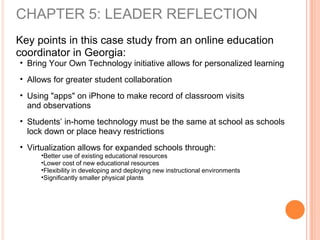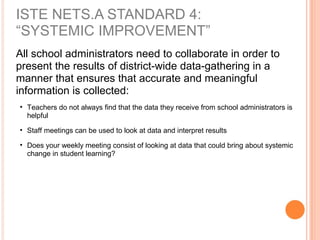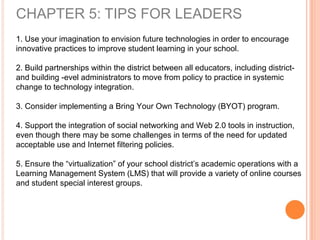Chapter 5
- 1. EDUCATIONAL LEADERSHIP IN TECHNOLOGY: PREPARING SCHOOL ADMINISTRATORS FOR A DIGITAL AGE BY VIRGINIA E. GARLAND AND CHESTER TADEJA Chapter 5: Systemic Change with Personnel and Partnerships in Technology
- 2. CHAPTER 5: SYNOPSIS • NETS.A Standard 4: “Systemic Improvement” • Lead purposeful change to maximize improvement • Data analysis of improved student learning • Strategic partnerships • Leader survey for Chapter 5 skill sets • Discussion questions
- 3. CHAPTER 5: LEADER REFLECTION Key points in this case study from a chief information officer in Kansas: • Core ideas must be aligned with the use of technology and available resources • Inspiration to provide personalized student learning • Imagination to accurately envision the future • Innovation to better understand the future of technology • Provide "Education Beyond Expectations" through personalized learning for students • Digital citizenship goes beyond the concept of possessing inherent skills • Expect administrators to model the use of technology to teachers • Integrate technology with instruction
- 4. Key points in this case study from an online education coordinator in Georgia: • Bring Your Own Technology initiative allows for personalized learning • Allows for greater student collaboration • Using "apps" on iPhone to make record of classroom visits and observations • Students’ in-home technology must be the same at school as schools lock down or place heavy restrictions • Virtualization allows for expanded schools through: •Better use of existing educational resources •Lower cost of new educational resources •Flexibility in developing and deploying new instructional environments •Significantly smaller physical plants CHAPTER 5: LEADER REFLECTION
- 5. CHAPTER 5: INTRODUCTION • Explanation of NETS.A Standard 4 • Collaboration to establish metrics • Leverage strategic partnerships • Working with technology-skilled personnel
- 6. ISTE NETS.A STANDARD 4: “SYSTEMIC IMPROVEMENT” Improved student performance is linked to the use of media-rich technologies. Superintendents and curriculum coordinators should apply research on the use of model academic programs in which technology is infused Principals can support new, interactive technologies for student learning by encouraging teachers to share examples of best practice in their instruction
- 7. ISTE NETS.A STANDARD 4: “SYSTEMIC IMPROVEMENT” All school administrators need to collaborate in order to present the results of district-wide data-gathering in a manner that ensures that accurate and meaningful information is collected: • Teachers do not always find that the data they receive from school administrators is helpful • Staff meetings can be used to look at data and interpret results • Does your weekly meeting consist of looking at data that could bring about systemic change in student learning?
- 8. School district leaders should align their curriculum, learning outcomes, and technology goals as they plan for the ongoing recruitment, hiring, and evaluation of professional staff members. The most important factor in school improvement efforts is the teachers because they are the ones who most directly affect student learning: • Evaluation can be done using digital-age technologies • Districts should also provide meaningful professional development for all staff in the effective use of emerging technologies • In his or her recruitment efforts, a superintendent must therefore hire “tech savvy” professional staff members who can create a technology vision for themselves and the students whom they will serve ISTE NETS.A STANDARD 4: “SYSTEMIC IMPROVEMENT”
- 9. Strategic partnerships are formed to improve student learning: • Blogs, Tweets, wikis, and social networking sites can contribute to learning improvement • Promote local, national, and even global partnerships with the use of collaborative technologies The need to have strategic planning for the integration of technology innovations and the implementation of effective interoperability standards is just as important as the learning taking place: • Existing technologies should also be evaluated as newer digital tools are investigated • Evaluation of administrative systems for their cost-effectiveness in such operations as purchasing, transportation scheduling, and course scheduling should be on-going ISTE NETS.A STANDARD 4: “SYSTEMIC IMPROVEMENT”
- 10. CHAPTER 5: TECHNOLOGY LEADERSHIP SELF-ASSESSMENT SURVEY • Self-scoring survey • Based on National Educational Technology Standards and Performance Indicators for Administrators (NETS.A) Standard 4 (NETS.A 4.a, 4.b, 4.c, 4.d, 4.e) • Ratings of 1 or 2 indicate areas of needed professional growth • Assessment can also be used to create an individualized e-portfolio
- 11. CHAPTER 5: TIPS FOR LEADERS 1. Use your imagination to envision future technologies in order to encourage innovative practices to improve student learning in your school. 2. Build partnerships within the district between all educators, including district- and building -evel administrators to move from policy to practice in systemic change to technology integration. 3. Consider implementing a Bring Your Own Technology (BYOT) program. 4. Support the integration of social networking and Web 2.0 tools in instruction, even though there may be some challenges in terms of the need for updated acceptable use and Internet filtering policies. 5. Ensure the “virtualization” of your school district’s academic operations with a Learning Management System (LMS) that will provide a variety of online courses and student special interest groups.
- 12. CHAPTER 5: TIPS FOR LEADERS 6. Use faculty meetings to share and interpret student test score data in order to provide intervention strategies while learning occurs. 7. Use digital-age tools in developing hiring policies that attract “tech savvy” teachers; use emerging technologies to retain and evaluate the most effective educators. 8. In addition to district-wide collaborations, develop partnerships between schools and the community and between educational leaders and the wider online professional community. 9. Schedule frequent evaluations of currently used software programs, such as Schoolmaster Student Information Systems or PowerSchool, in order to maintain accuracy in entering and maintaining student records.
- 13. 1. Make a list of organizations near your community with which you or your school can partner. In another column, describe what that relationship could look like specifically, and describe the benefits to students that this kind of relationship could bring, especially as it relates to systemic improvement. On the bottom of your paper, pick one of the organizations you selected and draw a time line of how this kind of relationship could be solidified from possibility to reality. 2. In a small group, turn to three or four other people and discuss the possibility of leading purposeful change in your immediate or global organization. Outline a few challenges that this could bring. Make sure each person in your group contributes equally in some way and be prepared to discuss your findings with the larger group. 3. How does your organization use data? What kinds of data are analyzed and in what ways are you encouraged to make interpretations of that data and present your findings? If your organization does not participate in the use of data, what ways could data be used in your organization, especially as it relates to improving student learning? CHAPTER 5: DISCUSSION QUESTIONS
- 14. 4. Describe your organization’s teacher evaluation process, especially as it relates to improving teacher performance. In what ways is the data used to recommend changes to encourage differentiated instruction? 5. In the first leader reflection for this chapter, De Young refers to three core ideas of “imagination,” “inspiration,” and “innovation” in the technology change efforts of his school district. What value do you place on these ideas? How are you and administrators in your district taking a leadership role in this type of digital-age systemic change? CHAPTER 5: DISCUSSION QUESTIONS
- 15. 6. In the second leader reflection of this chapter, Mashburn comments on the use of wireless technologies to conduct teacher observations by a principal in his district: “Administrators who take the time and effort to make classroom visits to see technology-enhanced lessons have more technology enhanced lessons in their schools. Dr. Gary Davidson of Lambert High School is one such principal. He uses an ‘app’ on his iPhone to record his classroom visits, and emails the teacher with his observation as he is leaving the classroom.” What are the most effective ways for supervisors to use wireless technologies in order to observe, evaluate, and retain “tech-savvy” teachers? 7. Based on your responses to the self-assessment for Chapter 5, what are the next steps you might take in becoming a more effective change agent in the use of digital-age technologies in your school or district? What is the district lacking or proud of in terms of “tech-savvy” personnel? What technology resources would you need in your own professional e- portfolio in order to assist you in achieving your goals? CHAPTER 5: DISCUSSION QUESTIONS















